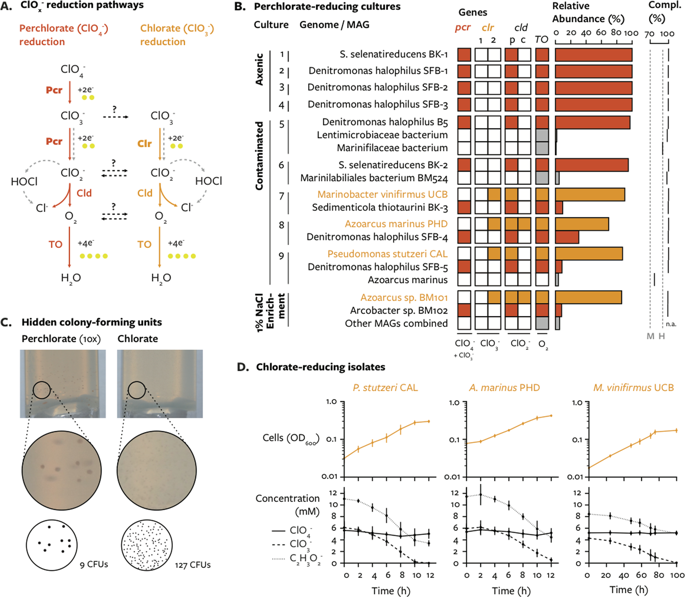Our official English website, www.x-mol.net, welcomes your feedback! (Note: you will need to create a separate account there.)
Identification of a parasitic symbiosis between respiratory metabolisms in the biogeochemical chlorine cycle.
The ISME Journal ( IF 11.0 ) Pub Date : 2020-02-05 , DOI: 10.1038/s41396-020-0599-1 Tyler P Barnum 1 , Yiwei Cheng 2 , Kaisle A Hill 1 , Lauren N Lucas 1 , Hans K Carlson 3 , John D Coates 1
The ISME Journal ( IF 11.0 ) Pub Date : 2020-02-05 , DOI: 10.1038/s41396-020-0599-1 Tyler P Barnum 1 , Yiwei Cheng 2 , Kaisle A Hill 1 , Lauren N Lucas 1 , Hans K Carlson 3 , John D Coates 1
Affiliation

|
A key step in the chlorine cycle is the reduction of perchlorate (ClO4-) and chlorate (ClO3-) to chloride by microbial respiratory pathways. Perchlorate-reducing bacteria and chlorate-reducing bacteria differ in that the latter cannot use perchlorate, the most oxidized chlorine compound. However, a recent study identified a bacterium with the chlorate reduction pathway dominating a community provided only perchlorate. Here we confirm a metabolic interaction between perchlorate- and chlorate-reducing bacteria and define its mechanism. Perchlorate-reducing bacteria supported the growth of chlorate-reducing bacteria to up to 90% of total cells in communities and co-cultures. Chlorate-reducing bacteria required the gene for chlorate reductase to grow in co-culture with perchlorate-reducing bacteria, demonstrating that chlorate is responsible for the interaction, not the subsequent intermediates chlorite and oxygen. Modeling of the interaction suggested that cells specialized for chlorate reduction have a competitive advantage for consuming chlorate produced from perchlorate, especially at high concentrations of perchlorate, because perchlorate and chlorate compete for a single enzyme in perchlorate-reducing cells. We conclude that perchlorate-reducing bacteria inadvertently support large populations of chlorate-reducing bacteria in a parasitic relationship through the release of the intermediate chlorate. An implication of these findings is that undetected chlorate-reducing bacteria have likely negatively impacted efforts to bioremediate perchlorate pollution for decades.
中文翻译:

鉴定生物地球化学氯循环中呼吸代谢之间的寄生共生。
氯气循环中的关键步骤是通过微生物呼吸途径将高氯酸盐(ClO4-)和氯酸盐(ClO3-)还原为氯化物。减少高氯酸盐的细菌和减少氯酸盐的细菌的不同之处在于后者不能使用高氯酸盐,这是氧化程度最高的氯化合物。但是,最近的一项研究发现,具有氯酸盐还原途径的细菌在仅提供高氯酸盐的群落中占主导地位。在这里,我们确认了高氯酸盐和减少氯酸盐的细菌之间的代谢相互作用,并确定了其机理。减少高氯酸盐的细菌支持减少氯酸盐的细菌的生长,达到社区和共培养物中总细胞总数的90%。减少氯酸盐的细菌需要使氯酸盐还原酶的基因与减少高氯酸盐的细菌共培养,表明氯酸盐是相互作用的原因,而不是随后的中间体亚氯酸盐和氧气。相互作用的模型表明,专门用于还原氯酸盐的细胞在消耗由高氯酸盐产生的氯酸盐方面具有竞争优势,尤其是在高浓度高氯酸盐的情况下,因为高氯酸盐和氯酸盐在减少高氯酸盐的细胞中竞争单一酶。我们得出的结论是,减少高氯酸盐的细菌会通过释放中间氯酸盐而无意中以寄生关系支持大量减少氯酸盐的细菌。这些发现的含义是几十年来未发现的减少氯酸盐的细菌可能对生物修复高氯酸盐污染的努力产生了负面影响。相互作用的模型表明,专门用于还原氯酸盐的细胞在消耗由高氯酸盐产生的氯酸盐方面具有竞争优势,尤其是在高浓度高氯酸盐的情况下,因为高氯酸盐和氯酸盐在减少高氯酸盐的细胞中竞争单一酶。我们得出的结论是,减少高氯酸盐的细菌会通过释放中间氯酸盐而无意中以寄生关系支持大量减少氯酸盐的细菌。这些发现的含义是数十年来未发现的减少氯酸盐的细菌可能对生物修复高氯酸盐污染的努力产生了负面影响。相互作用的模型表明,专门用于还原氯酸盐的细胞在消耗由高氯酸盐产生的氯酸盐方面具有竞争优势,尤其是在高浓度高氯酸盐的情况下,因为高氯酸盐和氯酸盐在减少高氯酸盐的细胞中竞争单一酶。我们得出的结论是,减少高氯酸盐的细菌会通过释放中间氯酸盐而无意中以寄生关系支持大量减少氯酸盐的细菌。这些发现的含义是几十年来未发现的减少氯酸盐的细菌可能对生物修复高氯酸盐污染的努力产生了负面影响。尤其是在高氯酸盐浓度下,因为高氯酸盐和氯酸盐在还原高氯酸盐的细胞中竞争单一酶。我们得出的结论是,减少高氯酸盐的细菌会通过释放中间氯酸盐而以寄生关系无意地支持大量减少氯酸盐的细菌。这些发现的含义是几十年来未发现的减少氯酸盐的细菌可能对生物修复高氯酸盐污染的努力产生了负面影响。尤其是在高氯酸盐浓度下,因为高氯酸盐和氯酸盐在还原高氯酸盐的细胞中竞争单一酶。我们得出的结论是,减少高氯酸盐的细菌会通过释放中间氯酸盐而无意中以寄生关系支持大量减少氯酸盐的细菌。这些发现的含义是几十年来未发现的减少氯酸盐的细菌可能对生物修复高氯酸盐污染的努力产生了负面影响。
更新日期:2020-02-06
中文翻译:

鉴定生物地球化学氯循环中呼吸代谢之间的寄生共生。
氯气循环中的关键步骤是通过微生物呼吸途径将高氯酸盐(ClO4-)和氯酸盐(ClO3-)还原为氯化物。减少高氯酸盐的细菌和减少氯酸盐的细菌的不同之处在于后者不能使用高氯酸盐,这是氧化程度最高的氯化合物。但是,最近的一项研究发现,具有氯酸盐还原途径的细菌在仅提供高氯酸盐的群落中占主导地位。在这里,我们确认了高氯酸盐和减少氯酸盐的细菌之间的代谢相互作用,并确定了其机理。减少高氯酸盐的细菌支持减少氯酸盐的细菌的生长,达到社区和共培养物中总细胞总数的90%。减少氯酸盐的细菌需要使氯酸盐还原酶的基因与减少高氯酸盐的细菌共培养,表明氯酸盐是相互作用的原因,而不是随后的中间体亚氯酸盐和氧气。相互作用的模型表明,专门用于还原氯酸盐的细胞在消耗由高氯酸盐产生的氯酸盐方面具有竞争优势,尤其是在高浓度高氯酸盐的情况下,因为高氯酸盐和氯酸盐在减少高氯酸盐的细胞中竞争单一酶。我们得出的结论是,减少高氯酸盐的细菌会通过释放中间氯酸盐而无意中以寄生关系支持大量减少氯酸盐的细菌。这些发现的含义是几十年来未发现的减少氯酸盐的细菌可能对生物修复高氯酸盐污染的努力产生了负面影响。相互作用的模型表明,专门用于还原氯酸盐的细胞在消耗由高氯酸盐产生的氯酸盐方面具有竞争优势,尤其是在高浓度高氯酸盐的情况下,因为高氯酸盐和氯酸盐在减少高氯酸盐的细胞中竞争单一酶。我们得出的结论是,减少高氯酸盐的细菌会通过释放中间氯酸盐而无意中以寄生关系支持大量减少氯酸盐的细菌。这些发现的含义是数十年来未发现的减少氯酸盐的细菌可能对生物修复高氯酸盐污染的努力产生了负面影响。相互作用的模型表明,专门用于还原氯酸盐的细胞在消耗由高氯酸盐产生的氯酸盐方面具有竞争优势,尤其是在高浓度高氯酸盐的情况下,因为高氯酸盐和氯酸盐在减少高氯酸盐的细胞中竞争单一酶。我们得出的结论是,减少高氯酸盐的细菌会通过释放中间氯酸盐而无意中以寄生关系支持大量减少氯酸盐的细菌。这些发现的含义是几十年来未发现的减少氯酸盐的细菌可能对生物修复高氯酸盐污染的努力产生了负面影响。尤其是在高氯酸盐浓度下,因为高氯酸盐和氯酸盐在还原高氯酸盐的细胞中竞争单一酶。我们得出的结论是,减少高氯酸盐的细菌会通过释放中间氯酸盐而以寄生关系无意地支持大量减少氯酸盐的细菌。这些发现的含义是几十年来未发现的减少氯酸盐的细菌可能对生物修复高氯酸盐污染的努力产生了负面影响。尤其是在高氯酸盐浓度下,因为高氯酸盐和氯酸盐在还原高氯酸盐的细胞中竞争单一酶。我们得出的结论是,减少高氯酸盐的细菌会通过释放中间氯酸盐而无意中以寄生关系支持大量减少氯酸盐的细菌。这些发现的含义是几十年来未发现的减少氯酸盐的细菌可能对生物修复高氯酸盐污染的努力产生了负面影响。


























 京公网安备 11010802027423号
京公网安备 11010802027423号